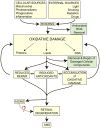Consequences of oxidative stress in age-related macular degeneration
- PMID: 22510306
- PMCID: PMC3392472
- DOI: 10.1016/j.mam.2012.03.009
Consequences of oxidative stress in age-related macular degeneration
Abstract
The retina resides in an environment that is primed for the generation of reactive oxygen species (ROS) and resultant oxidative damage. The retina is one of the highest oxygen-consuming tissues in the human body. The highest oxygen levels are found in the choroid, but this falls dramatically across the outermost retina, creating a large gradient of oxygen towards the retina and inner segments of the photoreceptors which contain high levels of polyunsaturated fatty acids. This micro-environment together with abundant photosensitizers, visible light exposure and a high energy demand supports a highly oxidative milieu. However, oxidative damage is normally minimized by the presence of a range of antioxidant and efficient repair systems. Unfortunately, as we age oxidative damage increases, antioxidant capacity decreases and the efficiency of reparative systems become impaired. The result is retinal dysfunction and cell loss leading to visual impairment. It appears that these age-related oxidative changes are a hallmark of early age-related macular degeneration (AMD) which, in combination with hereditary susceptibility and other retinal modifiers, can progress to the pathology and visual morbidity associated with advanced AMD. This review reassesses the consequences of oxidative stress in AMD and strategies for preventing or reversing oxidative damage in retinal tissues.
Copyright © 2012 Elsevier Ltd. All rights reserved.
Figures
References
-
- Al-Shabrawey M, Bartoli M, El-Remessy AB, Platt DH, Matragoon S, Behzadian MA, Caldwell RW, Caldwell RB. Inhibition of NAD(P)H oxidase activity blocks vascular endothelial growth factor overexpression and neovascularization during ischemic retinopathy. Am J Pathol. 2005;167 (2):599–607. - PMC - PubMed
-
- Altuntas I, Dane S, Gumustekin K. Effects of cigarette smoking on lipid peroxidation. J Basic Clin Physiol Pharmacol. 2002;13 (1):69–72. - PubMed
-
- Ames BN. Optimal micronutrients delay mitochondrial decay and age-associated diseases. Mechanisms of ageing and development. 2010;131 (7–8):473–479. - PubMed
-
- Ames BN, Shigenaga MK. Oxidants are a major contributor to aging. Annals of the New York Academy of Sciences. 1992;663:85–96. - PubMed
Publication types
MeSH terms
Substances
Grants and funding
LinkOut - more resources
Full Text Sources
Other Literature Sources
Medical



